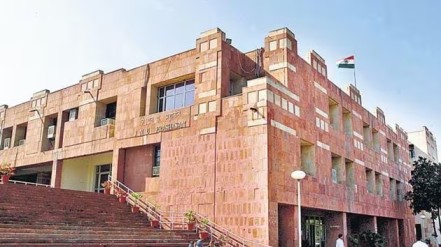The Delhi University Admin Cycle of ad-hoc replacement strikes at LSR, as reputed teachers from departments get replaced. What follows is absolute silence from the college administration.
After the ad-hoc replacements of Mr. Samarveer Singh at Hindu College, and Dr. Itisha Nagar at KNC, the unsettling trend continues, with Ms. Pushplata Kumar from LSR being the most recent case.
On 20th July, 2024, the esteemed Department of Journalism, at Lady Shri Ram College(LSR) suffered a crucial setback when the news of the non-retention of Ms. Pushplata was received. This comes as a part of the continual cycle of Delhi University, wherein the ad-hoc professors are being granted permanent status, while some ad-hoc professors are being replaced from their posts. However, the lack of transparency in the process, alleged political powerplay, and unjust temperament had sparked concern and discontentment amongst the students, at the loss of such qualified and cherished academicians. Protests by both DUTA and the students, have not resulted in any change in the opaque procedure undertaken by the University of Delhi.
Ms. Pushplata, who had been teaching under the aegis of the Journalism Department of LSR for 9 years as an ad-hoc professor, experienced a similar situation when her non-retention was notified. This comes as a shock to the students, most of whom credit her for their ignited interest in the subjects of Advertisement, Public Relations, Media Industry Management et al., and as a constant source of guidance in their career trajectories. Given the brevity of the situation, DU Beat reached out to students from the Department, and under the guise of Anonymity, they spoke about the unjust mannerism under which the department functions, the replacement of Pushplata Ma’am, being one of the many commented one of the Students, expanding upon the mismanagement within the Journalism Department. They further stated that most of the guest lectures and talks under their tenure were held by Ms. Pushplata, and through the exceptional network she had within the industry, she would also provide aid for students to obtain better career opportunities.
Since 2016, LSR has been the top college within DU for Journalism; for 5 consecutive years, and in 2020, the top four positions within Journalism were taken by LSR, so when the teacher(s) are giving such exemplary results, then their non-retention comes up as a greater dismay,
Another student from the department spoke about the zeal she developed within them for the subjects, sharing that,
She taught us the practicality of the subject, taught us how we can move beyond the scope of televised advertisements, and work for change. Ma’am made sure we attended film festivals, and introduced us to people from the industry, so that we could realize and work on the scope of our careers.
These testimonials from students become a vital point, in correlation to the fact that these decisions have a direct impact on the academic lives of the students, and thus, their consensus and feedback should be an important parameter before undertaking a drastic step like this.
The students took to social media to raise their opposition against this drastic step. This is a remarkable moment, given the “reduced sense of political temperament amongst the newcomers”, as alleged by an alumna of the college. In conversation with DU Beat, one of the students mentioned how this apoliticism of the students is a reflection of the improper supervision of the admin and the senior management of LSR,
Here at LSR, one can see the difference when a student enters here, and exits. They don’t bother talking about their concerns, for they know nothing would happen and a ‘Blame Chain’ would be formulated.
The incident at LSR further adds to the chain of questions about the opacity and unjust mechanisms used by the colleges and selection committees. And a perplexity about the lack of consensus from the students regarding a decision that not only has an impact on the reputation of the college, but also the academic (and otherwise) lives of the students.
Featured Image Credits: DU Beat
Shikhar Pathak














